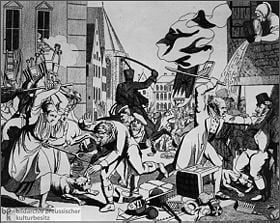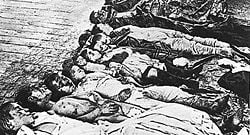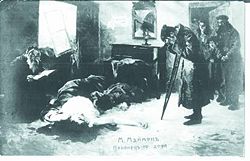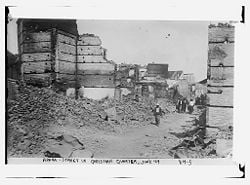Difference between revisions of "Pogrom" - New World Encyclopedia
m (→Ancient) |
m (→Russian Empire) |
||
| Line 25: | Line 25: | ||
{{main|Anti-Jewish pogroms in the Russian Empire}} | {{main|Anti-Jewish pogroms in the Russian Empire}} | ||
| − | The term ''pogrom'' as a reference to large-scale, targeted, and repeated antisemitic rioting saw its first use in the nineteenth century. | + | The term ''pogrom'' as a reference to large-scale, targeted, and repeated antisemitic rioting, saw its first use in the nineteenth century. The first pogrom named may have been the 1821 anti-Jewish riots in [[Odessa]] (modern [[Ukraine]]) after the death of the [[Eastern Orthodox Church|Greek Orthodox]] patriarch in [[Istanbul]], in which 14 Jews were killed. However, a much larger pogrom occurred in the same city in 1859, when Greek sailors from ships in the harbor, joined by local Greeks residents attacked the Jewish community of Odessa on Easter, blaming them as "Christ-killers." Further pogroms occurred her in 1871, 1881, and 1886. |
| − | The | + | The term "pogrom" became commonly used in English after a large-scale wave of anti-Jewish riots swept through south-western [[Imperial Russia]] in 1881–1884. The trigger for these pogroms was the [[Alexander II of Russia#Assassination|assassination of Tsar Alexander II]], for which some in the media and the churches blamed "the Jews." Local economic conditions are thought to have contributed significantly to the rioting as well. However, one of the assassins, [[Gesya Gelfman]], was indeed Jewish. The fact that the other assassins were all Christians had little impact on the spread of the rumor of Jewish responsibility. |
| − | + | A much bloodier wave of pogroms broke out in Russian and Eastern Europe in 1903–1906, leaving thousands of Jews dead and many more wounded, as the Jews took to arms to defend their families and property from the attackers. The 1905 pogrom against the Jews of[[Odessa]] was the most serious pogrom of the period, with reports of up to 2,500 Jews killed in that city alone. Some historians believe that some of the pogroms had been organized or supported by the [[Tsar]]ist Russian [[secret police]], the [[Okhrana]]. | |
| − | |||
| − | |||
| − | |||
| − | A much bloodier wave of pogroms broke out in 1903–1906, leaving thousands of Jews dead and many more wounded, as the Jews took to arms to defend their families and property from the attackers. | ||
[[Image:Maimon Home.jpg|thumb|250px|right|''Home at last'' by [[Moshe Maimon]].]] | [[Image:Maimon Home.jpg|thumb|250px|right|''Home at last'' by [[Moshe Maimon]].]] | ||
| − | [[Image:AdanaChristianQuarter.jpg|right|thumb|250px|A [[Adana massacre|1909 pogrom]] of Armenians in the Ottoman Empire claimed tens of thousands of lives, as Armenian and Christian property was burned en masse. | + | [[Image:AdanaChristianQuarter.jpg|right|thumb|250px|A [[Adana massacre|1909 pogrom]] of Armenians in the Ottoman Empire claimed tens of thousands of lives, as Armenian and Christian property was burned en masse.]] |
| − | |||
| − | |||
| − | |||
| − | |||
| − | Many pogroms accompanied the [[Revolution of 1917]] | + | Many pogroms accompanied the [[Revolution of 1917]], which targeted the [[Hasidic Judaism]] particularly resistant to the Soviet program. The ensuing [[Russian Civil War]] also found Jewish communities victimized by anti-Soviet forces who blamed the Jews for Communism. In all, an estimated 70,000 to 250,000 Jewis civilians were killed in the atrocities throughout the former [[Russian Empire]]; the number of Jewish orphans exceeded 300,000. |
===Outside Russia=== | ===Outside Russia=== | ||
Revision as of 22:05, 14 December 2008
A pogrom is a form of riot directed against a particular group, whether ethnic, religious, or other, and characterized by the killing and destruction of their homes, businesses, and religious centers. The term in English is often used to denote extensive violence against Jews—either spontaneous or premeditated—but it has also been applied to similar incidents against other minority groups.

The word "pogrom" Russian: погром came from the verb громить, Russian pronunciation: [grɐˈmʲitʲ] "to destroy, to wreak havoc, to demolish violently."
Pogroms against Jews
Ancient
Although the word pogrom is a modern one, riots directed against Jews go back to anicent times. Following the conquests of Alexander the Great, Jewish tradition holds that Greek forces committed atrocities against Jewish civilians in the second century B.C.E., leading to the Maccabean Revolt of 167. Similar anti-Jewish actions also reportedly took place in Africa under Greek rule, and there were antisemitic riots in Alexandria under Roman Empire in 38 C.E. during the reign of Caligula.
Evidence of communal violence against Jews—early Christians, who were seen as part of a Jewish sect—exists dating from the second century in Rome. These riots were generally precipitated by the Romans because Jews refused to accept Roman rule over Palestine. Once Christianity became the state religion of Rome, Christian mobs occasionally moved against Jewish synagogues.
Medieval
Although the Muslims had been relatively tolerant toward the Jews, in eleventh century saw several Muslim pogroms against Jews, such as those that occurred in Cordoba in 1011 and in Granada in 1066. In the 1066 Granada massacre, a Muslim mob crucified the Jewish vizier Joseph ibn Naghrela and massacred about 4,000 Jews.
Massive violent attacks against Jews by Christians date back at least to the Crusades, such as the pogroms of 1096 in France and Germany (the first to be officially recorded), as well as the massacres of Jews at London and York in 1189–1190.
During the Black Plague of 1348, Jews were massacred in Chillon, Basle, Stuttgart, Ulm, Speyer, Dresden, Strasbourg, and Mainz. A large number of the surviving Jews fled to Poland, which welcomed to Jews at the time.
Jews and Roman Catholics were both massacred during the Khmelnytsky Uprising of Ukrainian Cossacks in 1648–1654, as well as in the following century during the Koliyivshchyna.
Russian Empire
The term pogrom as a reference to large-scale, targeted, and repeated antisemitic rioting, saw its first use in the nineteenth century. The first pogrom named may have been the 1821 anti-Jewish riots in Odessa (modern Ukraine) after the death of the Greek Orthodox patriarch in Istanbul, in which 14 Jews were killed. However, a much larger pogrom occurred in the same city in 1859, when Greek sailors from ships in the harbor, joined by local Greeks residents attacked the Jewish community of Odessa on Easter, blaming them as "Christ-killers." Further pogroms occurred her in 1871, 1881, and 1886.
The term "pogrom" became commonly used in English after a large-scale wave of anti-Jewish riots swept through south-western Imperial Russia in 1881–1884. The trigger for these pogroms was the assassination of Tsar Alexander II, for which some in the media and the churches blamed "the Jews." Local economic conditions are thought to have contributed significantly to the rioting as well. However, one of the assassins, Gesya Gelfman, was indeed Jewish. The fact that the other assassins were all Christians had little impact on the spread of the rumor of Jewish responsibility.
A much bloodier wave of pogroms broke out in Russian and Eastern Europe in 1903–1906, leaving thousands of Jews dead and many more wounded, as the Jews took to arms to defend their families and property from the attackers. The 1905 pogrom against the Jews ofOdessa was the most serious pogrom of the period, with reports of up to 2,500 Jews killed in that city alone. Some historians believe that some of the pogroms had been organized or supported by the Tsarist Russian secret police, the Okhrana.
Many pogroms accompanied the Revolution of 1917, which targeted the Hasidic Judaism particularly resistant to the Soviet program. The ensuing Russian Civil War also found Jewish communities victimized by anti-Soviet forces who blamed the Jews for Communism. In all, an estimated 70,000 to 250,000 Jewis civilians were killed in the atrocities throughout the former Russian Empire; the number of Jewish orphans exceeded 300,000.
Outside Russia
Pogroms spread throughout Central and Eastern Europe. Anti-Jewish riots also broke out elsewhere in the world.
- During the Greek War of Independence, thousands of Jews were massacred by the Greeks to the point of complete elimination.
- In 1927, there were pogroms in Oradea (Romania).
- In the Americas, there was a pogrom in Argentina in 1919, during the Tragic Week [1] [2]
In the Arab world, there were a number of pogroms which played a key role in the massive emigration from Arab countries to Israel. These occurred during rising tensions and violence in Palestine as Jews tried to secure a homeland there.
- In 1945, anti-Jewish rioters in Tripoli, Libya killed 140 Jews.
- The Farhud pogrom in Iraq killed between 200 and 400 Jews.
There is also said to have been a Limerick Pogrom, in Ireland in the late nineteenth century. This pogrom was less violent than the others. Although it involved campaigns of intimidation, it chiefly took the form of an economic boycott against Jewish residents of Limerick.
During the Holocaust
Pogroms were also encouraged by the Nazis, especially early in the war before the larger mass killings began. The first of these pogroms was Kristallnacht in Nazi Germany, often called Pogromnacht, in which Jewish homes and businesses were destroyed, up to 200 Jews were killed and some 30,000 Jewish men and boys were arrested and sent to concentration camps.
A number of deadly pogroms occurred during the Holocaust at the hands of non-Germans, for example the Jedwabne pogrom of 1941, in which Polish citizens killed between 400 and 1,600 Jews (estimates vary), with German assistance. The region was previously occupied by the Soviet Union, (Ribbentrop-Molotov Pact) and the Jewish population was accused of collaboration with the Soviets.
In the city of Lwów (today Lviv), Ukrainian nationalists allegedly organized two large pogroms in June-July, 1941 in which around 6,000 [3] Jews were murdered, in apparent retribution for the alleged collaboration of some Jews with the previous Soviet regime (see Controversy regarding the Nachtigall Battalion).
In Lithuania, Lithuanian nationalists (led by Klimaitis) engaged in anti-Jewish pogroms for similar reasons as well, on 25 and 26 of June, 1941 (after the Nazi German troops had entered the city), killing about 3,800 Jews and burning synagogues and Jewish shops.[2] Perhaps the deadliest of these Holocaust-era pogroms was the Iaşi pogrom in Romania, in which as many as 13,266 Jews were killed by Romanian citizens, police, and military officials[citation needed].
After World War II
Even after the end of World War II, there were still a few pogroms in Poland, such as the Kraków pogrom on August 11, 1945 or the best known Kielce pogrom of 1946 [4], in which thirty-seven Jews were killed.
Until today, the debate in Poland continues as to whether the murderers in Kielce were leftists or rightists, and who inspired the killings, but the 1946 massacre was a turning point in the attempt to rebuild a Jewish community and convinced many Holocaust survivors that they had no future in Poland.
Anti-Jewish riots also broke out in several other Polish cities where many Jews were killed. (see: Anti-Jewish violence in Poland, 1944-1946) [5].
Soon after, Jews began to flee Poland. The vast majority of survivors left for several reasons. Many left simply because they did not want to live in a communist country. Some left because the refusal of the Communist regime to return prewar property[citation needed]. Others did not wish to rebuild their lives in the places where their families were murdered[citation needed], and others wanted to go to British Mandate of Palestine, which soon became Israel.
As a result the number of Jews in Poland decreased from 200,000 in the years immediately after the war to 50,000 in 1950 and to 6,000 by the 1980s. [6]
Serious acts of ethnic and religious violence in India,[3] such as the the 1984 anti-Sikh riots, the 2002 Gujarat violence, the 2007 Orissa violence and the 2008 attacks on North Indians in Maharashtra, tend to occur as the root causes of violence often run deep in history, religious activities, economic imbalance and politics of India.[4][5]
Influence of pogroms
The pogroms of the 1880s caused a worldwide outcry and, along with harsh laws, propelled mass Jewish emigration. Two million Jews fled the Russian Empire between 1880 and 1914, with many going to the United Kingdom and United States.
In reaction to the pogroms and other oppressions of the Tsarist period, Jews increasingly became politically active. Jewish participation in The General Jewish Labor Union, colloquially known as The Bund, and in the Bolshevik movements, was directly influenced by the pogroms. Similarly, the organization of Jewish self-defense leagues (which stopped the pogromists in certain areas during the second Kishinev pogrom), such as Hovevei Zion, led naturally to a strong embrace of Zionism, especially by Russian Jews.
Modern usage and examples
Other ethnic groups have suffered from similar targeted riots at various times and in different countries. In the view of some historians,[6] the mass violence and murder targeting Black people during the New York Draft Riots of 1863 can be defined as pogroms, though the word had not yet entered the English language at the time. The same could be said of the Chinese massacre of 1871 in Los Angeles, California, and of the killing of Koreans in the wake of the 1923 Great Kantō earthquake in Tokyo, Japan, after newspapers printed articles saying Koreans were systematically poisoning wells, seemingly confirmed by the widespread observation of wells with cloudy water (a little-known effect after a large earthquake).
In the 1955 Istanbul Pogrom, ethnic Greeks were attacked and overwhelmed by ethnic Turkish mobs. In the years leading up to the Biafran War, ethnic Igbos and others from southeastern Nigeria were victims of targeted attacks. The term is therefore commonly used in the general context of riots against various ethnic groups.[citation needed] Other examples include the pogroms against ethnic Armenians in Sumgait in 1988 and in Baku, in 1990, both of which occurred in Azerbaijan. The Jakarta Riots of May 1998 were pogroms targeted against ethnic Chinese in Indonesia. Businesses associated with Chinese were burnt down, women were raped, tortured and killed.[7] Fearing for their lives, many ethnic Chinese, who made up about 3–5% of Indonesia's population, fled the country.
Sikhs have also experienced a pogrom in India, most notably those occurring in November 1984 when India's Prime Minister Indira Gandhi was assassinated by two of her Sikh guards acting in the aftermath of Operation Bluestar. In these 1984 Anti-Sikh Riots, Sikhs were killed in pogroms led by government loyalists, with the government allegedly aiding the attacks by furnishing the mobs with voting lists to identify Sikh families.[8]. The current Congress party leader, Sonia Gandhi, officially apologized to the Sikh community in 1988 for the pogrom and began reconciliation efforts, as well as efforts to provide justice for the victims, the most notable being the Nanavati commission.
Another notorious pogrom in India happened in the state of Gujarat in March 2002, when Muslims were systematically targeted and killed (2002 Gujarat violence) [9]. This was in response to killing of Hindu pilgrims by setting a train compartment on fire by alleged Muslim miscreants. Estimates of the numbers killed range from below a thousand to two thousand. Some thirty cities and towns in the state were reported to be “still under curfew” till the end of March [10]
During the "troubles" in Northern Ireland, a disputed territory within the United Kingdom, pogroms have taken place at different times across the disputed territory. The most violent have taken place in the city of Belfast when unionist rioters attacked the small Nationalist housing estate known as the Short Strand (Irish: An Trá Ghearr). Three unionists and one nationalist were killed by gunfire here, on the 27th of june 1970 during the "Battle of St Mathews."
In 1999, after NATO troops took control of the Serbian province of Kosovo, the non-Albanian population of the capital Pristina was driven from their homes by ethnic Albanians and their property sacked and demolished.[11][12]
On 17 October 1999, at approximately 12:00 noon, members of the radical Basilist sect, led by Basili Mkalavishvili, an excommunicated Georgian Orthodox Church priest, interrupted the Christian meeting of a congregation of 120 Jehovah's Witnesses held in the "Giza" building, in Tbilisi-Gldani and viciously attacked many of the individuals who were in attendance. Men, women and children were physically attacked. Some were punched in the face, and when they fell to the ground, they were brutally kicked. Others were beaten with clubs and iron crosses. Women holding small children in their arms were also beaten while the children screamed. Following the attack, 16 injured members of the congregation were taken to the hospital for treatment. One woman, the mother of two, permanently lost some vision in one eye because of a blow to the head. Their property (including literature) was destroyed. [13]. Since 1999 to 2003 there were over 100 attacks and related incidents in Georgia. The houses of some Jehovah's Witnesses were burned. The victims have filed more than 800 criminal complaints. [14]
In May 2008, there were pogroms against foreigners across South Africa that left almost 100 people dead and up to 100 000 displaced. [15]
See also
- Anti-Semitism
- Race riot
- Ethnic cleansing
- Mass murder
- Hep-Hep riots
- Farhud
- Alexandria pogroms
- Istanbul pogrom
- Bohdan Khmelnytsky#Khmelnytsky in Jewish history
- Khmelnytsky Uprising#Jews and the Uprising
- Sumgait Pogrom
- Anti-Armenianism
- Anti-Jewish violence in Poland, 1944-1946
- Anti-Jewish riots in Britain, 1947
- Gretseskayia Operatsia
Notes
- ↑ Amos Elon (2002), The Pity of It All: A History of the Jews in Germany, 1743–1933. Metropolitan Books. ISBN 0805059644. p. 103
- ↑ Holocaust Revealed. www.holocaustrevealed.org. Retrieved 2008-09-02.
- ↑ Soul of India | PBS
- ↑ Essential Background: Overview of human rights issues in India (Human Rights Watch World Report 2008, 31-1-2008)
- ↑ Thousands homeless after Hindu-Christian violence in India, International Herald Tribune, August 29, 2008
- ↑ Foner, E. (1988). Reconstruction America's unfinished revolution, 1863-1877. The New American Nation series. Page 32. New York: Harper & Row.
- ↑ http://www.fas.org/irp/world/indonesia/indonesia-1998.htm Indonesia Country Report on Human Rights Practices for 1998
- ↑ Swadesh Bahadur Singh (editor of the Sher-i-Panjâb weekly): “Cabinet berth for a Sikh,” Indian Express, 1996-05-31.
- ↑ The Gujarat Pogrom of 2002
- ↑ Times of India, March 27, 2002.
- ↑ Interview with Cedomir Prelincevic, Chief Archivist of Kosovo and leader of the Jewish Community in Pristina (September 1999). Retrieved from http://emperors-clothes.com/interviews/ceda.htm on April 12, 2007.
- ↑ Reufi Prlinčević, Guljšen, "Kako su Jevreji u poslednjim ratovima proterani iz BiH i sa Kosmeta", Glas Javnosti, Glas Javnosti, 2003-09-01. Retrieved 2007-08-13. (written in Serbian)
- ↑ Application the Council of Justice of Georgia http://www.jw-media.org/region/europe/georgia/english/legal_cases/e_000911.htm
- ↑ Chronology of Acts of Violence and Intimidation http://jw-media.org/region/europe/georgia/
- ↑ Richard Pithouse, 'The Pogroms in South Africa: a crisis in citizenship' Mute Magazine, June 2008 http://www.metamute.org/en/the_pogroms_in_south_africa_a_crisis_in_citizenship
ReferencesISBN links support NWE through referral fees
|
Template:Antisemitism topics
|
Credits
New World Encyclopedia writers and editors rewrote and completed the Wikipedia article in accordance with New World Encyclopedia standards. This article abides by terms of the Creative Commons CC-by-sa 3.0 License (CC-by-sa), which may be used and disseminated with proper attribution. Credit is due under the terms of this license that can reference both the New World Encyclopedia contributors and the selfless volunteer contributors of the Wikimedia Foundation. To cite this article click here for a list of acceptable citing formats.The history of earlier contributions by wikipedians is accessible to researchers here:
The history of this article since it was imported to New World Encyclopedia:
Note: Some restrictions may apply to use of individual images which are separately licensed.


